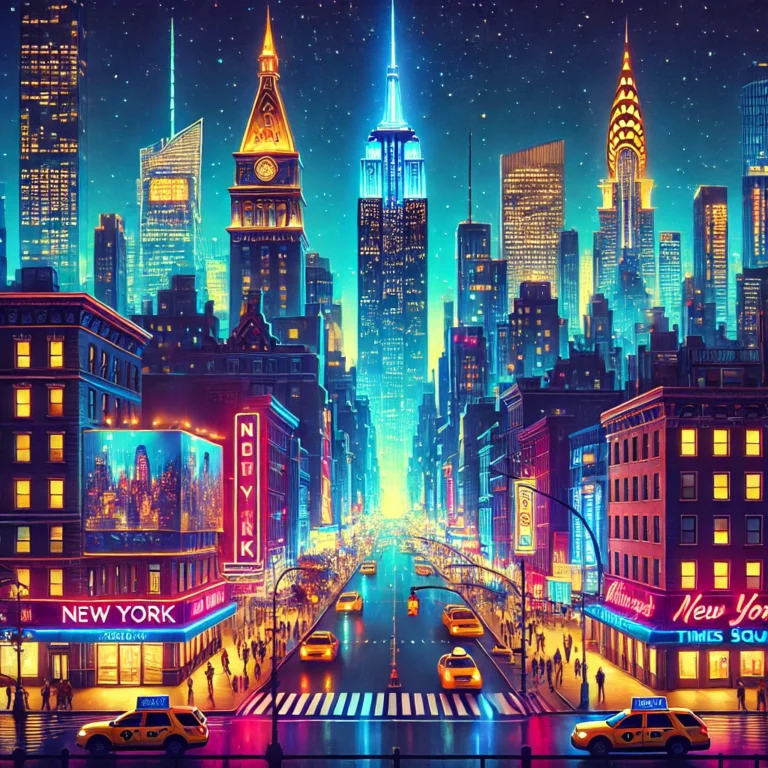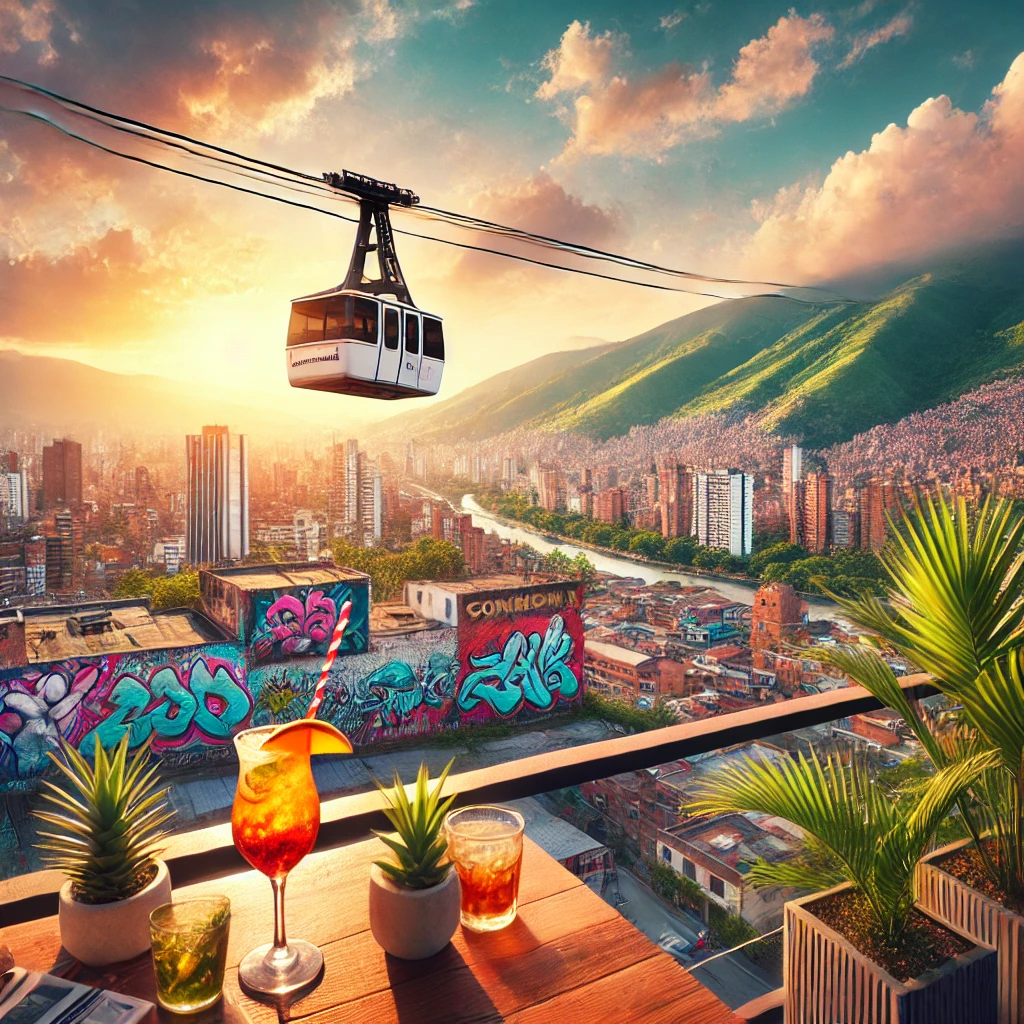
Visiting Medellín but short on time?
No worries!
This one-day itinerary will take you through the city’s most iconic spots, breathtaking views, and delicious eats, ensuring you soak up the best of the City of Eternal Spring in just 24 hours. 🌞🌿
Whether you’re here for culture, food, or adventure, this guide will help you experience the magic of Medellín in a single day. Let’s dive in!
☀️ Morning: Art, Culture & History
☀️ Morning: Art, Culture & History
1. Start Your Day at Plaza Botero & Museo de Antioquia (8:00 AM – 9:00 AM)

Medellín’s city center is the perfect place to start your adventure, and there’s no better introduction than Plaza Botero, a lively urban space showcasing the artistic legacy of Fernando Botero—one of Colombia’s most famous artists.
What to Expect at Plaza Botero:
✔️ 23 massive bronze sculptures scattered around the plaza, featuring Botero’s signature exaggerated proportions—from chubby cats to oversized human figures.
Each piece tells a unique story, often with humorous or thought-provoking themes.
✔️ Street performers and vendors selling everything from handmade souvenirs to fresh Colombian coffee ☕.
✔️ A great spot for photography, especially in the early morning when the light is soft and the crowds are minimal.
Museo de Antioquia (Right Next to the Plaza!)
After admiring the outdoor sculptures, head into the Museo de Antioquia, one of Colombia’s most important museums.
🎨 Why Visit?
✔️ It houses the largest collection of Botero’s artwork—from paintings to sketches and sculptures.
✔️ Features exhibits on Colombian history, indigenous art, and contemporary Latin American pieces.
✔️ The museum itself is inside a stunning colonial-era building, making it a sight to see.
👉 Pro Tip: Get here early (around 8:00 AM) to enjoy the sculptures before crowds arrive, and grab a fresh fruit juice from a nearby street vendor.
2. Explore the Colorful & Inspiring Comuna 13 (9:30 AM – 11:30 AM)
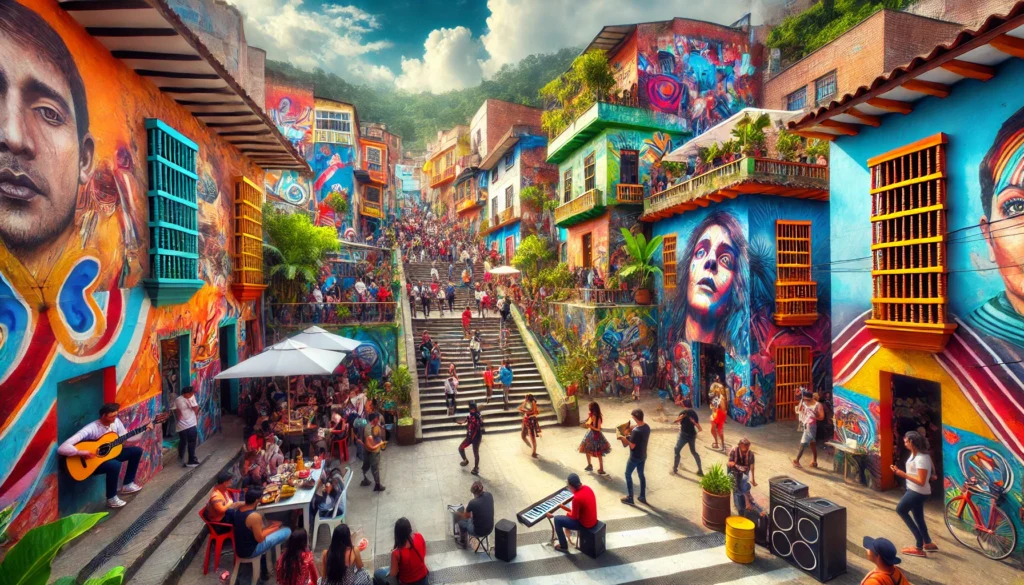
No visit to Medellín is complete without experiencing the transformation of Comuna 13, once one of the most dangerous neighborhoods in Colombia, now a vibrant symbol of resilience, art, and community revival.
How to Get There:
🚇 Take the Metro to San Javier Station (Line B).
From there, you can walk or take a short bus ride up to the main entrance of Comuna 13.
Why Comuna 13 is a Must-Visit:
✔️ Incredible street art murals covering nearly every wall, stairway, and alley—each piece tells a story of the neighborhood’s past, present, and future.
✔️ Innovative outdoor escalators, built to improve mobility for residents and now a symbol of Medellín’s urban transformation.
✔️ Live hip-hop performances and breakdancing shows 🎤—local artists frequently perform on the streets, adding to the electric energy.
✔️ Local shops and cafés, where you can grab a delicious fresh juice, Colombian coffee, or traditional snacks like empanadas and buñuelos.
Best Way to Explore?
🚶♀️ Join a guided tour! The history of Comuna 13 is fascinating but also complex.
A local guide will explain the neighborhood’s past, the role of art in its transformation, and the personal stories behind the murals.
Tour Highlights:
🎨 Graffiti walls with hidden meanings—many murals pay tribute to fallen heroes and tell stories of resilience.
🏡 Visit a local’s home or community space to hear firsthand accounts of the neighborhood’s rebirth.
🍉 Taste fresh tropical fruits from local street vendors—try guanábana (soursop), lulo, or passion fruit.
👉 Pro Tip: The best times to visit are in the morning or early afternoon.
It’s safer, cooler, and less crowded before the late-afternoon rush. If you’re visiting on a weekend, expect even more street performances!
🍽️ Afternoon: Stunning Views & Local Cuisine
3. Ride the Metrocable to Parque Arví (12:00 PM – 2:00 PM)
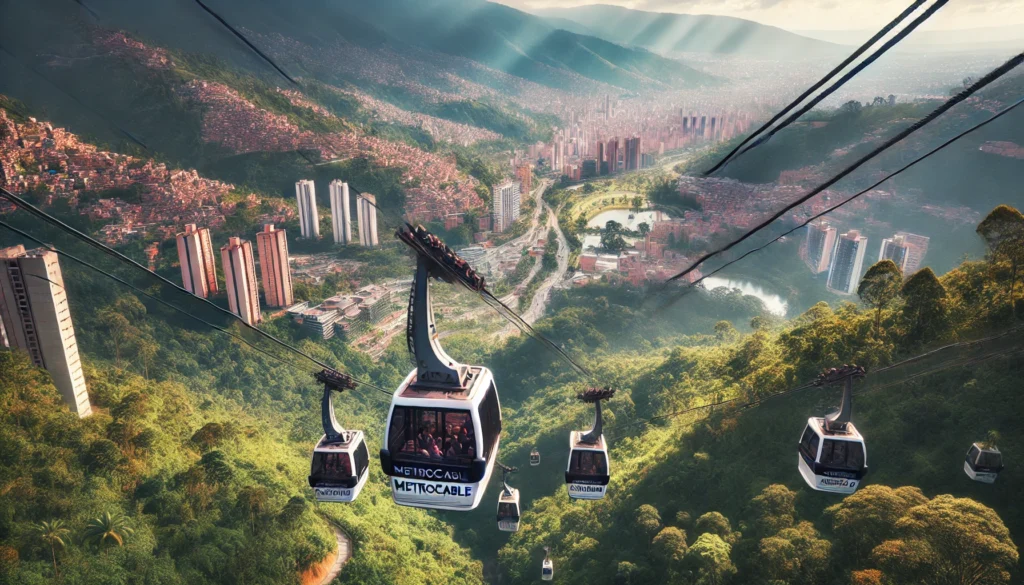
One of the best ways to experience Medellín’s natural beauty is by taking a ride on the Metrocable—the city’s innovative cable car system that connects urban neighborhoods to lush green landscapes. 🌿
🚠 Why Ride the Metrocable?
✔️ It’s a scenic journey offering breathtaking panoramic views of the city and surrounding mountains.
✔️ It’s affordable and safe—you can use your Metro ticket to access the cable car!
✔️ It gives you a unique look at Medellín’s hillside communities, many of which were once inaccessible before the city’s urban development.
How to Get to Parque Arví:
1️⃣ Take Medellín Metro Line A to Acevedo Station.
2️⃣ Transfer to Metrocable Line K (the gondola system) and ride to Santo Domingo Station—enjoy the stunning bird’s-eye view of the city along the way! 🏙️
3️⃣ Transfer again to Metrocable Line L (which leads directly to Parque Arví). This part of the journey takes you above dense forests and mountain landscapes.
⏳ Total ride time: ~30–40 minutes from downtown Medellín.
🌲 Arriving at Parque Arví: What to Do?
Once you step off the cable car, you’ll find yourself in a tranquil, lush natural park—a stark contrast to the urban energy of Medellín.
This is the perfect escape for nature lovers, hikers, and food enthusiasts.
🌿 Top Things to Do at Parque Arví:
✔️ Go for a nature walk – There are several well-marked hiking trails where you can breathe in fresh mountain air and spot exotic birds. 🦜
✔️ Visit the local farmers’ market – Try fresh Colombian coffee, organic honey, tropical fruits, and artisanal cheese from local vendors. 🍯🧀
✔️ Have a picnic in the forest – Pack some snacks and enjoy a relaxing break under the trees. 🍃
🍽️ Where to Eat at Parque Arví?
For a true taste of Antioquian cuisine, check out the small food stands at the entrance selling:
🥔 Arepas de choclo – A sweet, cheesy corn pancake served with butter.
🥩 Chorizo Antioqueño – Grilled sausage served with arepas.
🍵 Aguapanela con queso – A traditional hot sugarcane drink served with fresh cheese.
👉 Pro Tip: If you want a more structured tour of the park, there are eco-guides available at the visitor center who can take you on guided hikes with insights into the local flora and fauna.
4. Visit the Charming Pueblito Paisa (2:30 PM – 4:00 PM)

After soaking in the natural beauty of Parque Arví, make your way to Pueblito Paisa, a picturesque replica of a traditional Antioquian village, located on Cerro Nutibara, a hill that overlooks the entire city.
🏡 What is Pueblito Paisa?
✔️ A tiny, colorful village square designed to reflect what rural Colombian towns looked like in the past.
✔️ Features a church, small shops, a fountain, and a colonial-style town hall—all built in the classic white and red architecture of Antioquia.
✔️ A panoramic viewpoint offering one of the best 360° views of Medellín—perfect for golden-hour photography! 📸
🚶♂️ What to Do at Pueblito Paisa?
🌄 Take in the Stunning Views:
🏙️ From here, you can see the entire Medellín valley, surrounding mountains, and the city skyline. It’s a fantastic sunset spot, but it’s also beautiful in the afternoon with clear skies.
🏛️ Explore the Small Museum:
Inside the village, there’s a tiny museum showcasing artifacts and historical pieces from Antioquian culture—think old-school tools, pottery, and furniture from the 19th century.
🛍️ Shop for Souvenirs:
There are a few local artisan shops selling handmade crafts, such as:
✔️ Handwoven mochilas (colorful bags) from local Indigenous communities 🎒
✔️ Colombian coffee beans ☕ (A great gift idea!)
✔️ Miniature sculptures of Botero’s famous artworks 🎭
🍛 Where to Eat at Pueblito Paisa?
No trip to Pueblito Paisa is complete without trying some traditional Antioquian dishes.
Grab a seat at one of the local restaurants and order a classic Bandeja Paisa, a Colombian feast consisting of:
🍛 Red beans, rice, fried plantain, ground beef, chorizo, chicharrón (crispy pork belly), avocado, a fried egg, and arepas.
Too much food? Opt for smaller dishes like:
🥟 Empanadas – Deep-fried pastries filled with meat, potatoes, and spices.
🫓 Arepa con queso – A warm corn cake stuffed with gooey melted cheese.
👉 Pro Tip: Try a fresh fruit juice—Colombia is known for exotic flavors like lulo, guanábana, and passionfruit. 🥭🍊
Why Visit Pueblito Paisa?
✔️ It’s an easy and quick visit – You only need about 1 hour to explore the entire area.
✔️ It’s a great cultural stop – You get a taste of small-town Colombia without leaving the city.
✔️ The views are unbeatable – Whether you come in the afternoon or at sunset, the lookout point is one of the best in Medellín.
🌙 Evening: Nightlife & Dining in El Poblado
🌙 Evening: Rooftop Views, Fine Dining & Vibrant Nightlife
After a day of exploring Medellín’s history, culture, and natural beauty, it’s time to wind down with sunset drinks, an amazing dinner, and a taste of the city’s legendary nightlife.
The best place to experience this?
El Poblado—Medellín’s trendiest and most vibrant district!
5. Sunset Drinks at a Rooftop Bar (5:00 PM – 6:30 PM)
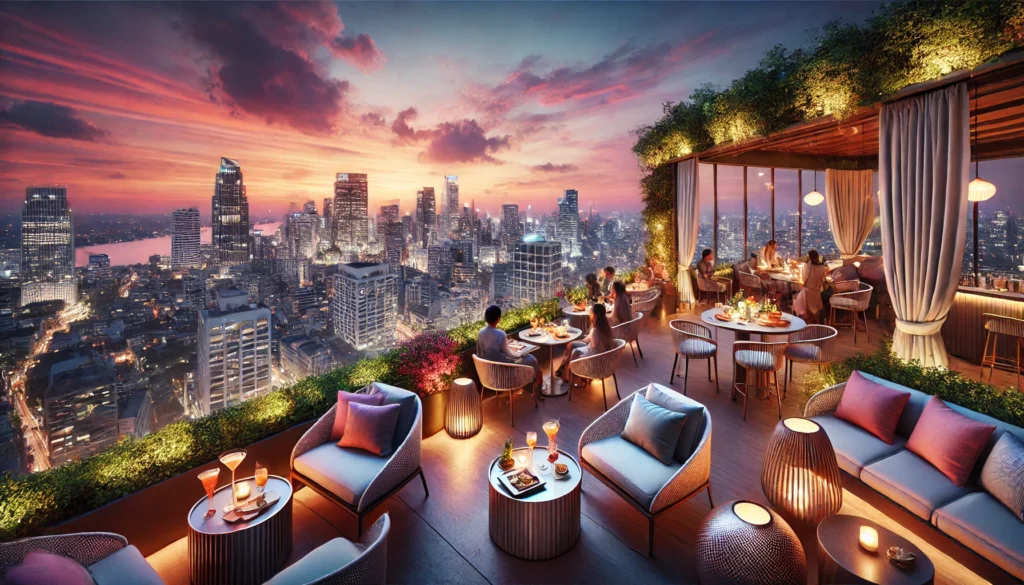
As the sun sets over the Medellín valley, there’s no better way to enjoy golden hour than with a cocktail in hand at one of El Poblado’s chic rooftop bars.
The city is known for its breathtaking skyline views, and a rooftop bar offers the perfect vantage point.
🍹 Top Rooftop Bars for Sunset Views:
✔️ Envy Rooftop (at The Charlee Hotel) – One of the most famous rooftop bars in Medellín, featuring a glass-walled infinity pool, DJs spinning chill beats, and spectacular city views. Best for a luxury vibe.
✔️ Alambique – A hidden rooftop gem with a relaxed atmosphere, leafy décor, and artistic design. Their cocktails are creative, and the vibe is laid-back yet elegant.
✔️ 360 Rooftop Bar – True to its name, this bar offers a 360-degree view of the city, along with excellent mojitos, caipirinhas, and small tapas plates.
✔️ Los Patios Rooftop – A social rooftop bar perfect for meeting other travelers. They have affordable cocktails and craft beer, plus a great view of the sunset.
👉 Pro Tip: Arrive around 5:00 PM to grab the best seats and watch the sunset over the mountains.
6. Indulge in Medellín’s Food Scene (7:00 PM – 9:00 PM)
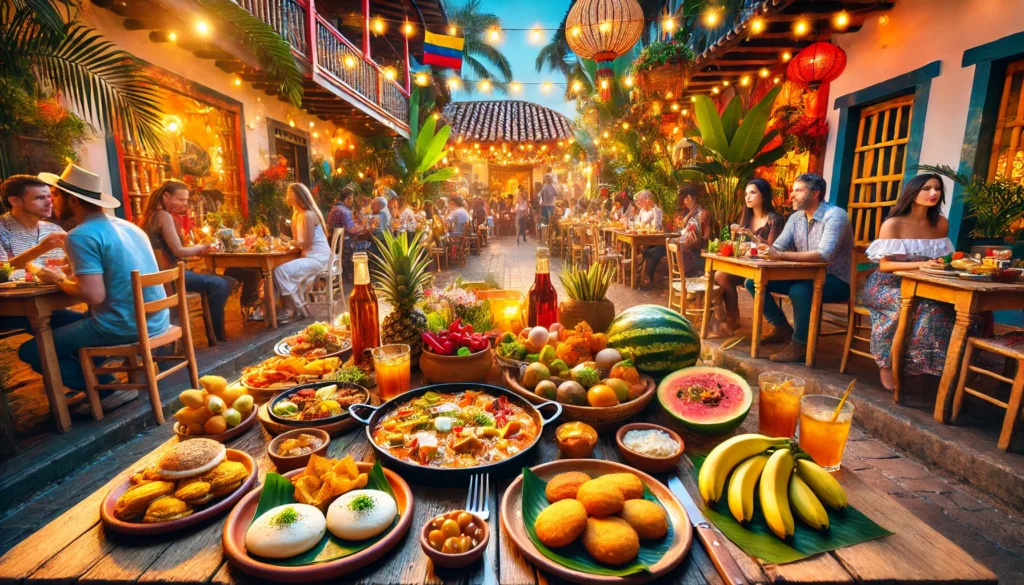
After a refreshing sunset drink, it’s time to dive into Medellín’s incredible food scene.
Whether you’re craving fine dining, Colombian classics, or fusion cuisine, El Poblado is packed with world-class restaurants.
🥩 Best Restaurants in Medellín for Dinner:
✔️ Carmen – One of the top-rated restaurants in Medellín, specializing in Colombian fusion cuisine with gourmet touches.
Think: locally sourced ingredients, creative plating, and a romantic, candlelit ambiance.
✔️ Oci.Mde – Known for slow-cooked meats, rich Colombian flavors, and cozy vibes.
If you love tender, fall-off-the-bone short ribs or handmade pastas, this is your spot.
✔️ El Cielo – A Michelin-starred restaurant that offers a sensory dining experience with artistic presentations and molecular gastronomy techniques.
If you’re in the mood for a once-in-a-lifetime meal, book a table here.
✔️ Mondongo’s – Want something more traditional?
This famous restaurant serves Colombian comfort food like bandeja paisa and mondongo (tripe soup).
A must-visit for an authentic experience.
🍷 Not in the mood for Colombian food? Check out:
- Colosal – Steakhouse with an incredible hilltop view of the city.
- Kabuki – One of the best sushi spots in Medellín.
- Zorba – Cozy, artsy wood-fired pizza spot with a bohemian vibe.
👉 Pro Tip: Many top restaurants require reservations, so book ahead if you’re visiting on a weekend!
7. End the Night with Salsa, Live Music & Cocktails (9:30 PM – Late)
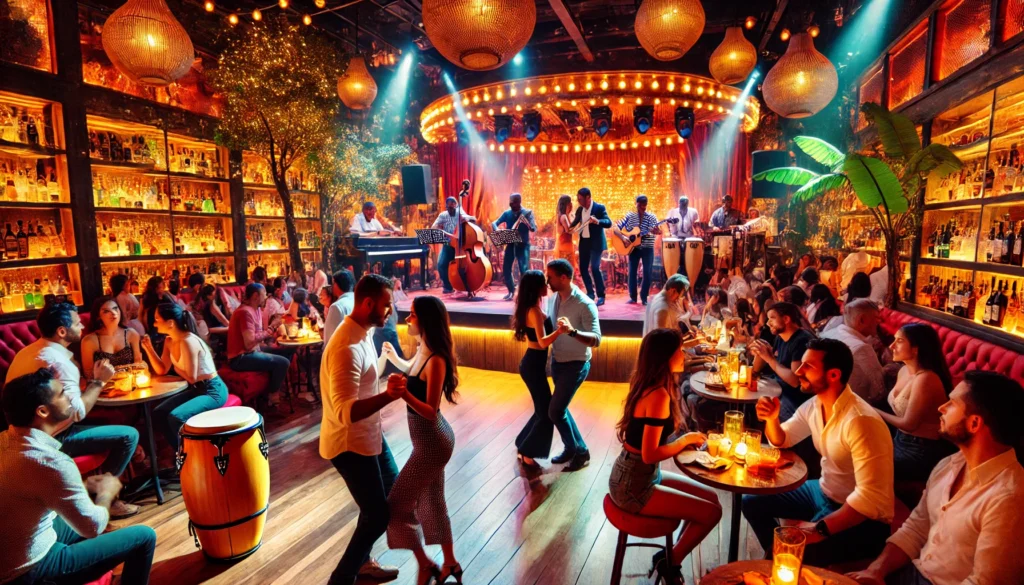
Medellín comes alive at night!
Whether you want to dance salsa, sip cocktails at a hidden speakeasy, or party until sunrise, El Poblado offers something for every type of traveler.
🎵 Best Places for Salsa Dancing & Latin Music:
💃 Son Havana – One of the most famous salsa bars in Medellín, with live Cuban music, energetic dancers, and an old-school Latin vibe.
Even if you’re new to salsa, locals will gladly teach you a few moves!
🎺 El Tibiri – A tiny underground salsa club with a sweaty, packed dance floor and authentic Latin beats. If you want a true Colombian salsa experience, this is the place to go.
🎸 La Pascasia – More into live music and indie bands? This artsy venue hosts Colombian folk, jazz, and experimental music in an intimate setting.
🍸 Best Cocktail Bars & Speakeasies:
✔️ Salón Málaga – A classic, old-school bar that transports you back to the golden days of Medellín.
Great for traditional Colombian drinks like Aguardiente and Ron Medellín.
✔️ Mad Radio – A hidden speakeasy with great craft cocktails, electronic beats, and a moody ambiance.
✔️ 23 Bar – Perfect for gin lovers! They specialize in gin & tonic variations, and the atmosphere is stylish but not pretentious.
🎉 Best Nightclubs for Dancing & Partying:
✔️ Perro Negro – A favorite among locals and expats, playing a mix of Latin, hip-hop, and reggaeton. Great crowd and a fun, unpretentious vibe.
✔️ Vintrash – A multi-level bar with a rooftop terrace, neon lights, and a mix of EDM, Latin beats, and throwback music.
✔️ La Octava – Ever wanted to party in a giant ball pit? This quirky club has one, along with great music and a fun, backpacker-friendly atmosphere.
🕛 What Time Should You Head Out?
✔️ For salsa dancing: Arrive around 9:30 – 10:00 PM—this is when the best live music starts.
✔️ For cocktail bars: Anytime between 8:00 – 11:00 PM.
✔️ For nightclubs: Medellín clubs get busy after midnight and stay open until 3:00 – 4:00 AM.
👉 Pro Tip: Taxis and Uber are safe in Medellín, but always double-check your driver’s information before getting in.
👗 What to Wear in Medellín: Stylish & Practical Outfits for Every Adventure
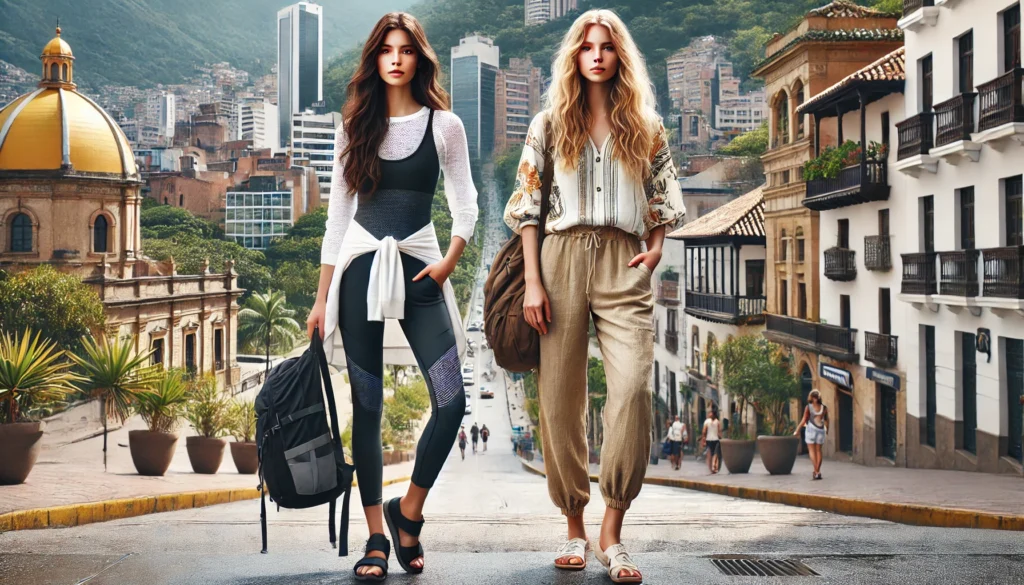
Medellín’s spring-like weather year-round makes packing a breeze, but the city’s mix of urban exploration, cultural hotspots, and nightlife means you’ll want outfits that are both comfortable and stylish. Whether you’re strolling through Plaza Botero, exploring Comuna 13’s vibrant murals, or sipping cocktails at a rooftop bar, here’s how to dress like a pro in the City of Eternal Spring! 🌿🌞
🌞 Daytime Chic: Exploring the City in Style
Medellín’s daytime temperatures range from 65-80°F (18-27°C), making light and breathable outfits ideal. You’ll want to look put-together but still comfortable for walking, climbing stairs, and hopping on the Metrocable.
✔️ For Women:
👗 Flowy midi dresses or lightweight jumpsuits – Stylish but comfy for walking.
👕 Breathable tops + high-waisted shorts or linen pants – Great for warm afternoons.
👟 Comfy sneakers or stylish sandals – You’ll be walking a lot!
✔️ For Men:
👕 Light cotton shirts or polo tees – Keep it breathable.
👖 Chinos or casual shorts – A smart but relaxed look.
👟 Sneakers or loafers – Ideal for city walks.
👉 Pro Tip: Medellín is a stylish city, so ditch the touristy cargo shorts & flip-flops—locals dress smart-casual!
🎨 Artsy & Bold: What to Wear in Comuna 13
Exploring Comuna 13’s iconic street art and hip-hop culture calls for bold and colorful fashion! It’s the perfect spot to experiment with vibrant outfits that match the creative energy of the murals.
✔️ Statement pieces: Bright-colored shirts, printed skirts, or funky sneakers.
✔️ Layer up: A light denim jacket or flowy kimono for the breezy hilltop views.
✔️ Sunglasses & hat: Keep cool while walking through the murals.
✔️ Crossbody bag or backpack: Stay hands-free for taking amazing photos.
👉 Pro Tip: Wear comfy walking shoes—you’ll be climbing stairs and navigating steep streets!
🌆 Sunset Glam: Rooftop Bars & Nightlife Ready
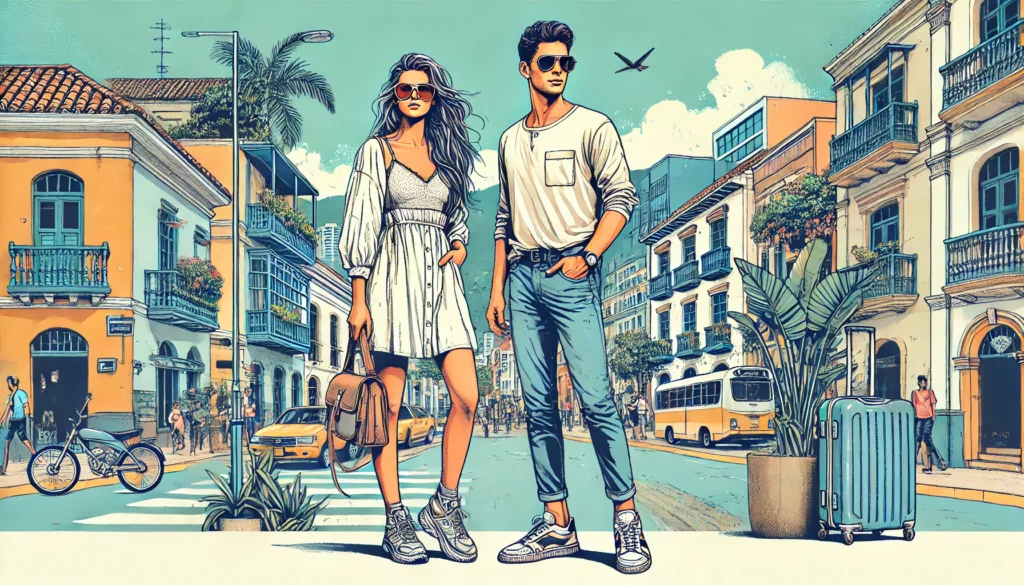
When the sun sets, Medellín turns up the style! Whether you’re grabbing cocktails at a rooftop bar or dancing salsa at Son Havana, a chic outfit is a must.
✔️ For Women:
✨ Elegant bodycon dress or jumpsuit – Sleek and perfect for rooftop cocktails.
👠 Block heels or stylish flats – Avoid stilettos if you’re walking on cobblestone streets.
💄 Bold lipstick & statement earrings – Effortless but polished.
✔️ For Men:
🖤 Fitted button-down shirt – Solid colors or subtle prints look classy.
👖 Dark jeans or slim-fit trousers – Smart but comfortable.
👞 Loafers or dress sneakers – Keep it stylish but relaxed.
👉 Pro Tip: Medellín’s nightlife scene is fashion-forward, so go for a sophisticated but effortless look!
🏔️ Adventure Mode: What to Wear for a Metrocable Ride & Parque Arví
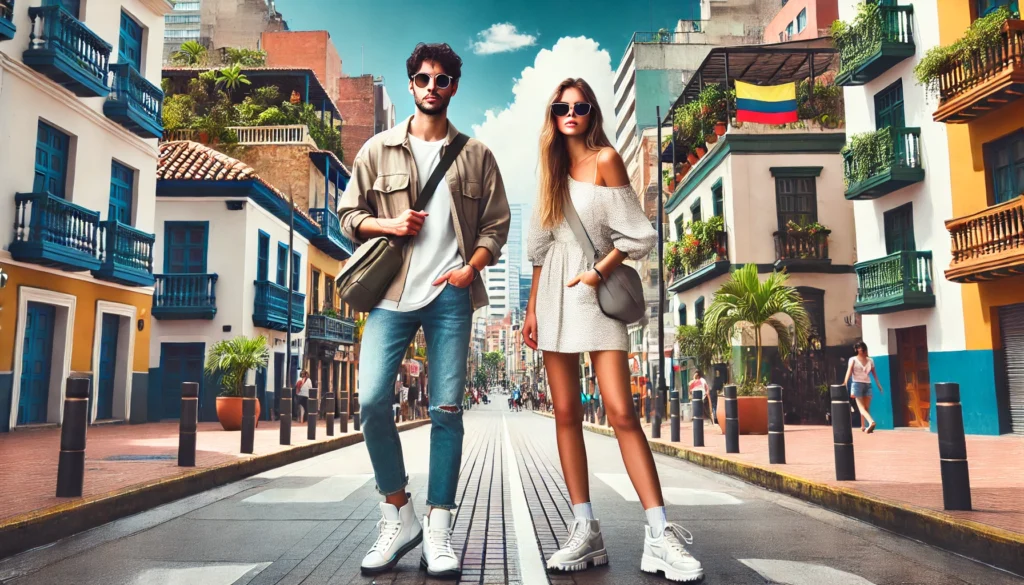
If you’re taking the scenic Metrocable ride to Parque Arví, you’ll want an outfit that’s comfortable for the journey and perfect for an impromptu nature walk.
✔️ Athleisure outfit: Stylish leggings & a breathable top for women; joggers & a t-shirt for men.
✔️ Comfy sneakers or hiking sandals: Be ready for walking trails!
✔️ Light jacket or windbreaker: It can be chillier at the top (especially in the evening).
✔️ Backpack: Pack water, sunscreen, and snacks for the trip.
👉 Pro Tip: If you’re visiting the farmers’ market at Parque Arví, bring a tote bag for goodies like fresh coffee and artisanal cheese! 🧀☕
💼 Medellín Packing List: Essentials You Shouldn’t Forget!
✅ Sunscreen – Medellín’s sun is stronger than you think! ☀️
✅ Sunglasses & hat – Protect yourself from midday heat.
✅ A lightweight rain jacket – Afternoon showers are common, so be prepared. 🌧️
✅ A stylish crossbody bag or anti-theft backpack – Keep your belongings secure.
✅ Light scarf or sweater – For breezy evenings.
Dress Smart & Feel Confident in Medellín!
Medellín is vibrant, stylish, and diverse—so pack outfits that are comfortable, fashionable, and adventure-ready. Whether you’re exploring colorful streets, hitting up trendy bars, or riding the Metrocable into the hills, you’ll look amazing while blending in with the local style!
🌎 What’s your go-to travel outfit? Drop your style tips in the comments! 👇
Ending the Perfect Day in Medellín
🌆 Whether you spent your evening sipping cocktails at a rooftop bar, indulging in gourmet Colombian cuisine, or dancing until dawn, one thing is for sure—Medellín is a city that knows how to have fun!
✨ What part of this itinerary are you most excited to try?
Let me know in the comments! 👇
🔖 📌 Don’t forget to Pin this guide for your next trip to Medellín!
Related Articles:
The Ultimate Guide: 12 Best Places to Visit in Spain for Every Type of Traveler


